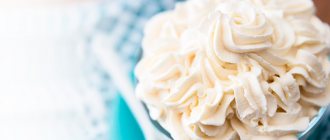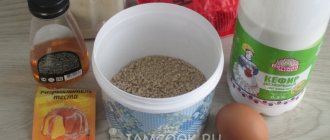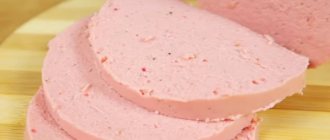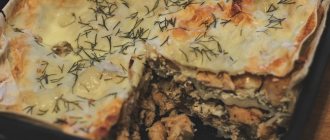Cottage cheese belongs to the category of fermented milk products.
It is mainly obtained from milk or kefir - during a certain processing, the thickened mass (curd) formed in the milk (kefir) is separated from the whey, which is then strained.
Equipment for making cottage cheese:
To make cottage cheese at home, you do not need any specialized equipment. As a rule, to prepare it it is enough to have:
– two pots of different sizes or a thermos;
– thermometer;
– slotted spoon;
– a sieve and gauze (if you don’t have gauze on hand, you can use clean, undyed linen or cotton fabric).
At the same time, the simplest recipe allows you to get by with just one pan and gauze. It is advisable to use aluminum pans rather than enamel ones, since in enamel pans the milk may burn when heated, which will negatively affect the taste of the final product. Choose pans with thick walls and bottoms - they retain heat longer and do not change shape over time. The main advantages of such products include the speed of preparation, which makes it possible to save a little on gas or electricity.
It is preferable to use a thermos with a capacity of at least 1 liter, with a wide neck.
It is better to choose a thermometer with a large dial and a clip holder, specially adapted for preparing cottage cheese and yoghurt at home.
Skimmers are made of stainless steel and nylon. Also sometimes there are skimmers made of plastic and polypropylene. It is preferable to choose stainless steel, because it is quite durable and easy to maintain. Ideally, the instructions should indicate what maximum temperature each model can withstand, usually around 200 °C. As for the handle, it can be made of the same material as the scoop, or of some other material. Often, ergonomic handles have special rubber or silicone inserts that prevent the kitchen accessory from slipping, even if you take it with a wet hand.
Sieves are made from different materials. Plastic is considered the most budget option. Wooden models are not practical and tend to absorb odors, so they are not suitable for working with dairy products. Sieves with stainless steel rims are of high quality.
Cottage cheese made from milk and lemon juice
A very quick way is to prepare healthy cottage cheese at home. Use any milk, it doesn’t matter in this recipe. Cottage cheese prepared according to this recipe turns out very tasty, but it is better not to use it for baking. Make light and airy desserts from it. Ingredients: Milk – 1 l Juice of half a lemon Preparation:
Before you start cooking, squeeze the juice out of the lemon. Place the pan with milk on the stove. Heat it well over low heat. As soon as signs of boiling appear, add lemon juice, stir and remove the pan from the heat. You will see the milk instantly curdle and the whey is separated immediately. Place the mixture in a colander and allow the whey to drain. Literally after 30 minutes you can eat the cottage cheese. This express recipe will come in handy when you want cottage cheese here and now. Despite the fact that it is prepared literally in a matter of minutes, this does not affect the taste in any way. You can make equally delicious cottage cheese using the following recipe.
What is cottage cheese made from?
The main raw material for making cottage cheese is milk. Some recipes will require additional ingredients, such as sour cream. All products used must be of the highest quality.
To make cottage cheese, you can use natural milk, pasteurized, ultra-pasteurized.
In urban areas, natural milk can be bought at the market or at a fair. This milk is not subjected to any processing, it is only filtered to remove mechanical impurities.
You can find pasteurized and UHT milk in most city supermarkets. This milk undergoes various processing methods.
Pasteurized milk is produced by heating once at 60°C for 60 minutes or at 70–80°C for 30 minutes. During pasteurization, vegetative forms of microorganisms in milk die, but the spores remain in a viable state and, when favorable conditions arise, begin to develop intensively. Therefore, pasteurized milk is stored at low temperatures for several days. It is believed that the nutritional value of milk remains virtually unchanged during pasteurization, since the taste and valuable components are preserved.
During ultra-pasteurization, milk is heated to a temperature of 135–150 °C for 2–3 seconds and immediately cooled to 4–5 °C. In this way, microflora and bacterial spores, which lead to milk souring, are removed from the milk, and the natural beneficial properties are preserved with minimal losses. After this treatment, milk can be stored for 6 weeks or longer at room temperature in special packaging. Such milk does not sour, as happens with regular milk, but simply goes rancid after a while. In most cases, you can make homemade cottage cheese from UHT milk.
Composition of cottage cheese
The beneficial properties and contraindications of cottage cheese are directly dependent on its composition. This natural milk-based product contains the following components:
- Vitamin B.
- Beta carotene.
- Ascorbic acid.
- Tocopherol.
- Lactic acid.
- Niacin.
- Iron, calcium, magnesium, sodium.
Interesting to know! The fat content of cottage cheese affects its protein and lactic acid content. The lower it is, the higher their percentage.
Cottage cheese is good because it is easily digested by the gastrointestinal tract. And most of its beneficial substances are easily absorbed by the body.
Calorie content of cottage cheese
The calorie content of cottage cheese directly depends on the percentage of its fat content. It goes like this:
- Fat cottage cheese (about 18%) – 200 calories.
- Bold (9%) – 170 calories.
- Low fat (5%) – 120 calories.
- Low-fat cottage cheese – 80 calories.
Calorie content was calculated per 100 g of fermented milk product.
How to make cottage cheese at home from milk?
If you want to prepare not only regular, but also low-fat cottage cheese, you will need a milk separator - a special apparatus that separates milk into skim milk and cream. There are also separators for working with cottage cheese. They separate fermented milk into curds and whey. But such equipment, as a rule, is used only in industrial production.
Cottage cheese is produced by fermenting milk and removing the whey. It is produced from whole, as well as partially or completely skimmed pasteurized milk.
Based on appearance (texture), a distinction is made between cottage cheese of a traditional layered texture, obtained by separating the whey by pressing, and soft dietary cottage cheese, which has a delicate paste-like consistency, obtained by separating the whey using a separator.
Low-fat cottage cheese can be obtained from skim milk after separation, after adding buttermilk (low-fat cream, a by-product of butter production). It is obtained by fermenting milk with pure cultures of lactic acid streptococci and flavor-forming bacteria, sometimes adding rennet.
At home, cottage cheese can be fermented with fresh sour cream in the amount of 50–80 g per 1 liter of milk. Pasteurized milk is poured into a thermos or other container and the temperature is brought to 26–28 °C in summer and 32–34 °C in winter. After pre-mixing the starter, it is added to the milk. The fermented milk is stirred several times during the first three hours. Fermentation using the acid method (with sour cream) lasts 6–8 hours. Whether the clot is ready is determined by the breakdown and the color of the serum. Use a teaspoon to make a break in the mass - a normal clot has smooth edges with a smooth surface, and the whey is transparent and yellow in color.
To speed up the release of whey, the finished curd is cut with a knife into small cubes with edges measuring 1.5–2 cm. To speed up the release of whey, the clot is heated to a temperature of 36–40 °C (with a tubular heater, which is carefully placed in a thermos, or by slowly pouring water at a temperature 60–65 °C), stand for 15–20 minutes, after which the whey is removed.
The resulting clot is poured into clean gauze, calico or lavsan bags with a clean ladle, tied and hung for 1 hour for self-pressing, preferably at a temperature not exceeding 16 °C. Then the cottage cheese is pressed until ready under pressure in a special plastic form, shaking and turning the bag over several times. It is advisable to carry out pressing at a temperature no higher than 6 °C (to avoid increasing the acidity of the cottage cheese).
Cottage cheese can be prepared in other ways: by fermenting in natural conditions, using kefir or yogurt, and also using calcium chloride.
To prepare 1 kg of cottage cheese you will need about 3 liters. milk.
How to make cottage cheese from sour milk
For those who are faced with the question of how to make cottage cheese from sour milk at home for the first time, there is a simple solution to this problem:
- the modern method of cooking has not undergone any changes over the years, which cannot be said about the industry;
- get a delicious curd from well-heated yogurt or sour milk;
- it is placed in a linen bag to separate the dense part from the liquid, which is whey;
- for these purposes, use enameled dishes or those made of stainless steel that do not have chips or defects;
- the process of expressing is accelerated with the help of small weights suspended from the bottom of the gauze in which the curd mass is located;
- It is strictly not recommended to use powder concentrate, since the finished dish will be far from natural, with less fat content and a less pronounced taste;
- experienced housewives prepare the delicacy in the evening, since all the whey has time to drain overnight and in the morning they can please their household with a healthy, nutritious breakfast.
Classic recipe from fresh and sour milk
There is one universal method that runs on its own and does not require your direct participation in the process. It cannot be called fast, since you will receive the finished mass only on the second or third day, but ripening will be absolutely natural and will keep all the beneficial lactic acid bacteria alive.
In the classic version, for 1 kg of cottage cheese, you will need:
- 3 liters of fresh milk, if possible not pasteurized;
- a colander and 2 spacious dishes - one large, the second smaller;
- clean thick gauze or cotton cloth.
The classic cooking process has not changed for many years and is completely simple.
So, how to make cottage cheese at home from milk, recipe:
- pour the main ingredient into a sealed container and leave it until it completely sours for a couple of days;
- Heat the container with the fermented dense mixture in a water bath over low heat;
- Stir the mixture constantly and cook it for about 15-20 minutes until curd lumps form;
- when the heated mixture separates into two parts, set it aside and let cool;
- use a large bowl and place a colander on it, covering it with cloth or gauze;
- Never use a sieve or fine cloth for these purposes;
- pour the contents onto the prepared material and tie it in a tight knot so that the whey drips from it;
- Once all the liquid has drained and stopped dripping, your curd will be ready.
The second option, how to make cottage cheese from sour milk, can give an unpredictable result, but does not require any effort:
- Immediately place the sour milk in a thick cloth and hang it over the container to drain the liquid;
- gauze will be irrelevant, since it will have to be folded in many layers due to the delicate texture of the main component; the protein will still leak through the holes.
Recipe for naturally fermented cottage cheese:
Pour pasteurized milk into a small saucepan and place in a warm place for 30 hours. At this time, it should not be shaken or stirred, as this will deteriorate the quality of the curd curd. After the specified time, the milk will turn into curdled milk and whey liquid.
Place the pan on the stove over very low heat and heat without bringing to a boil. To better control the temperature, you can use a water bath - place a saucepan with fermented milk in another larger saucepan with water, and the water should reach no more than the middle of the saucepan with yogurt. If fermented milk is overheated, the curd may turn out to be excessively dry and will crumble, and if the curdled milk is not heated enough, the curd will turn out sour, since the whey will not separate well enough.
During heating, the milk mass should not be stirred with a spoon - this will disrupt the process of whey separation. During heating, you should periodically check the temperature by simply touching the pan to prevent overheating. Heat until characteristic curd clots and clear whey appear, that is, about half an hour. After this, remove the pan from the heat and leave to cool - it will take approximately 6-8 hours until it cools completely.
Then put the cottage cheese with a slotted spoon on a sieve or pour the contents of the pan into a jar through cheesecloth, then leave the cottage cheese for a while to drain. If the cottage cheese was placed in gauze, hang it over the sink or bathtub; if in a sieve, place it over any container so that the liquid has somewhere to drain. It should drain for about an hour and a half until it is completely ready: if you leave it for a longer period, the product may become excessively dry.
The process of producing cottage cheese based on kefir
Raw materials - kefir
Place in a warm place to quickly separate the whey. After separating it, the pan with kefir is placed in a water bath and heated to directly obtain the curd mass. Placing the mixture in a gauze (cloth) bag will help the whey drain out. Production of homemade cottage cheese using the cold method. The following recipe for making cottage cheese is quite popular: 1 liter of kefir in a package is placed in the freezer for 3 days, after which the frozen product is taken out, placed in a colander with gauze and wait for the whey to separate.
The end result is a tender and very tasty cottage cheese.
Recipe for making cottage cheese using sourdough:
Ingredients:
1 liter of milk, 50 g of sour cream or kefir
This technology allows you to get cottage cheese faster. Pour the milk into a jar, add sour cream or kefir and leave in a warm place for ripening. Adding fermented milk products will give the cottage cheese a special taste and significantly speed up the ripening process: depending on the temperature, it can take from 12 hours to a day.
The milk should not be stirred during fermentation. When the milk mixture turns into yogurt, you need to take a clean saucepan, put a jar of yogurt in it and pour in enough water so that it is approximately at the same level with the yogurt. After this, you need to remove the jar and put the pan on the fire. After bringing the water to a boil, turn off the heat and place a jar of fermented milk in a saucepan with hot water. Cover the jar with a lid and leave for about half an hour. After the specified time has passed, remove the jar from the water and let stand for another 40–45 minutes. After this, pour the contents of the jar onto cheesecloth and hang the resulting curd clot over the bathtub or sink for two hours.
Great video with a great recipe! Worth a look!
And further:
Cooking methods and recipes
There are many ways to make delicious and healthy cottage cheese. Making cottage cheese at home from milk has many options:
- classical method in a water bath;
- using a microwave oven;
- by baking in the oven;
- You can also make it in a slow cooker.
In the microwave
One of the most basic recipes, which was created literally for lazy people. All you need is a package of sour milk or kefir. It must be poured into a container suitable for a microwave oven and, without covering with a lid, put into it for 10 minutes, setting the power to full. Next, drain the resulting water and enjoy the dish.
In the oven
A labor-intensive process that requires attention and strict adherence to recommendations. It is a variation on the theme of how to cook cottage cheese from sour milk:
- 5 hours before readiness, the jar of sour milk is brought into a warm room;
- the acidic product easily comes off the glass and easily rotates when the container is turned;
- the jar should not be completely full, there should be 1-2 cm free up to the neck;
- it must be placed in a cold oven and left for 40-50 minutes at a temperature of 120-150 degrees;
- then turn off the oven and leave the product in it until it cools completely, it is best if you cooked it in the evening so that it stands until the morning.
In a slow cooker
A modern method of cooking in a slow cooker will require a liter of high-fat milk, a 150-gram jar of natural yogurt, a teaspoon of sugar and salt. Everything is placed in a bowl and mixed thoroughly, after which it is cooked for half an hour according to the milk porridge program. If there is no such thing, then the same 30 minutes at a temperature of 95 degrees. When everything is ready, the whey is filtered through a sieve.
What is cottage cheese starter?
Curd starter is intended for fermenting milk and preparing cottage cheese at home.
Sourdough will allow you to always have fresh and high-quality cottage cheese on hand. It fills the human body with energy, pleases with a pleasant taste and light aroma. It is also a source of amino acids, milk protein, vitamins and microelements, lactose and fat, which are easily absorbed by the body. But if it is not fresh, you can get poisoned, so you should choose it carefully at the market or in a store. Better yet, cook it yourself.
The process of preparing a homemade product from sour milk is quite lengthy. But curd starter significantly reduces the time and gives confidence that it will be truly useful. It is also worth paying attention to the fact that buying a starter is also profitable, since one bottle is enough to ferment 1-3 liters of milk. Moreover, you can use both cow and goat.
Lactic bacteria contained in the starter ferment whole milk and turn it into curd. In a water bath, it is necessary to separate it from the whey, which also has beneficial qualities, a refreshing and pleasant taste. It is also suitable for making bread and other delicacies. This clot is essentially milk protein, which is easily digestible even by a child’s body.
In addition, the starter contains methionine, a special amino acid that prevents fatty liver disease.
Where to buy sourdough for cottage cheese?
The easiest option is to buy ready-made sourdough. The most common place to purchase is pharmacies. There you can buy very good quality cottage cheese starter called “Evitalia”, “Pepsin”. In the form of a starter, you can also use lactobacterin or bifidobacterin purchased in the same pharmacies; it is advisable to use it in ampoules and not in powders. When making homemade cottage cheese, you can also use rennet starter from veal rennet, which is used in the industrial production of cottage cheese.
Source:
Recipes for making homemade cottage cheese from Irina Veremey’s book “Cooking cottage cheese, yogurt, kefir, fermented baked milk at home.”
Prepare the product in 100 minutes
Ingredients:
- 3 medium-sized lemons (can be replaced with 17 grams of citric acid);
- 3 liters of low-fat milk (3-4% fat).
The entire procedure for preparing cottage cheese according to this recipe will take no more than 100 minutes.
Let's get 500 grams of semi-fat cottage cheese, the calorie content of which is approximately 170 kcal/100 g (Used/F/U - 18 g/9 g/3 g).
Method for making cottage cheese from milk in 100 minutes:
- Squeeze the juice from the lemons (you should get about 120 ml of juice);
- Pour the milk and juice into the pan and mix everything well;
- We begin to heat the milk in a water bath, while occasionally stirring gently (i.e., without sudden movements);
- Heat until curd flakes form and the whey separates;
- As soon as the whey separates, turn off the heat and let it brew for 10 minutes - the flakes will gradually gather into a curd lump;
- Place the cottage cheese in a colander with gauze (we do the familiar procedure of straining the whey from the curd mass);
- After 20 minutes, remove the cottage cheese from the gauze and let it brew for 40 minutes;
- That's it - freshly prepared cottage cheese is ready in a hurry.
For another recipe using lemons, watch the video:
How to eat cottage cheese correctly for health benefits
It is recommended that an adult eat no more than 200 g of cottage cheese per day. This is the optimal daily norm. For children, it is only 100 g. This amount is enough for the body to receive all the necessary substances for its proper functioning.
Important! You should eat cottage cheese no more than 3 times a week to avoid possible harm to health.
You should not mix fermented milk product with sugar, as it does not become healthier. It is best to eat cottage cheese with honey or cottage cheese with sour cream and fruit. This is a perfect combination that many people like.
Use of a useful product in cosmetology
It is thanks to its unique and rich composition that many began to use cottage cheese during cosmetic procedures. It is beneficial for different skin types. Depending on the existing problems, it is possible to choose a curd mask that will effectively cope with them.
Note! Before applying the curd mass, it is recommended to conduct a sensitivity test to avoid an allergic reaction.
Cottage cheese is good for beauty if you use it according to the following recipes:
- Mask for problem skin . It is necessary to mix low-fat cottage cheese with sour cream. The finished mass is applied to the face in an even layer for 20 minutes, then washed off with warm water.
- Mask for dry skin . You need to mix 2 chopped bananas, 2 tbsp. l. cottage cheese and 1 tbsp. l. sour cream. Plus add 1 chicken yolk. A homogeneous mass is applied to the face for 20 minutes, after which it is carefully washed off with water.
- Mask for weakened hair . It is necessary to mix 3 tbsp. l. cottage cheese with 1 tbsp. l. natural honey and the same amount of olive oil. The finished product is applied to dry hair along the entire length. Leave the mask on for up to 30 minutes. Afterwards you need to wash your hair with shampoo.
Cosmetic procedures must be carried out regularly in order to fully appreciate the benefits of cottage cheese for skin and hair.
Health benefits of cottage cheese
Nutritionists and other specialists note the high benefits of cottage cheese for the human body. The following product properties are distinguished:
- Improves the functioning of the digestive system.
- Has a positive effect on the psycho-emotional state.
- Normalizes the function of the nervous system.
- Strengthens bone tissue, nails and hair.
- Improves the functioning of the visual organs.
- Maintains optimal hemoglobin levels.
- Improves the quality of metabolic processes.
Important! Homemade cottage cheese promotes better absorption of other products, which is its great health benefit.
Real cottage cheese is known to help lower blood cholesterol and thin the blood. It also has a beneficial effect on the functioning of the immune system.
What are the benefits of cottage cheese for men?
Men should not avoid consuming fermented milk product as it helps them stay healthy. Cottage cheese in this case has the following properties:
- Helps develop muscle mass.
- Improves the quality of seminal fluid.
- Strengthens the prostate gland.
Both fat and low-fat cottage cheese provide benefits.
What are the benefits of cottage cheese for women?
High quality fermented milk product is no less valuable for women. The benefits of homemade cottage cheese include the following:
- Strengthens hair and improves its overall condition.
- Helps grow strong and healthy nails.
- Allows you to cope with toxicosis.
- Relieves heartburn.
- It has a positive effect on the processes of fetal formation in pregnant women.
In addition, cottage cheese improves the quality of breast milk, which is important during lactation.
Use of cottage cheese in cooking
Healthy cottage cheese is eaten at night and for breakfast. It can be consumed fresh or after heat treatment.
Interesting to know! To make the fermented milk product more airy and tender during the cooking process, it is recommended to first pass it through a blender or sieve.
The most popular cottage cheese dishes are:
- Casserole.
- Syrniki.
- Vareniki.
- Paska.
- Cheesecakes.
Homemade and store-bought cottage cheese goes well with dried fruits, fresh fruits and berries. It also complements the taste of individual vegetables.










